Missing a tooth can impact more than just your smile; it can affect your ability to chew, speak clearly, and maintain the shape of your face. Fortunately, modern dentistry offers effective solutions to restore your smile and oral function. One popular and reliable option is a dental bridge. In Markham, dental bridges are a common treatment for replacing one or more missing teeth. They offer a fixed, stable way to fill the gap, preventing remaining teeth from shifting and helping maintain your oral health and appearance. If you’re in Markham and considering your options for tooth replacement, understanding dental bridges is an important step.
This guide provides a comprehensive overview of dental bridges, covering the different types available, the materials used, what you can expect during the procedure, cost considerations specific to the Markham area, and how they compare to other options like dental implants.
What is a Dental Bridge?
A dental bridge is a prosthetic device used to replace one or more missing teeth. As the name suggests, it “bridges” the gap left by the missing tooth (or teeth).
A bridge consists of two main parts:
- Pontic(s): These are the artificial teeth that fill the space where the tooth is missing.
- Abutments: These are the anchors that hold the pontic in place. Abutments are typically crowns placed on the natural teeth adjacent to the gap (called abutment teeth), or they can be supported by dental implants.
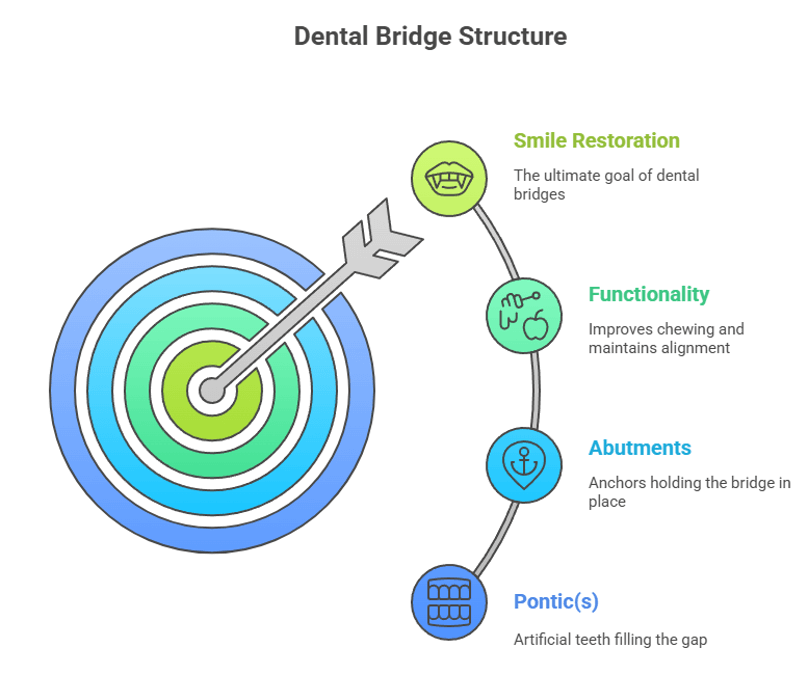
By securing a pontic to the abutments, a dental bridge effectively restores the appearance and function of your smile in the area of the missing tooth.
Why Are Dental Bridges Needed?
Beyond the aesthetic benefit of a complete smile, replacing missing teeth with a dental bridge is crucial for several reasons:
- Restores chewing and speaking ability: Fills the gap for normal function.
- Prevents remaining teeth from shifting: Keeps adjacent teeth in their proper positions, preventing misalignment issues.
- Maintains facial shape: Helps prevent the sunken look that can occur with missing teeth over time.
- Evenly distributes bite forces: Helps prevent excessive wear on remaining teeth.
Types of Dental Bridges
Several types of dental bridges are available, and the best option for you will depend on the location of the missing tooth, the condition of your adjacent teeth, and your overall oral health.
The most common types include:
1. Traditional Dental Bridge
This is the most common type of bridge. It is used when you have natural teeth on both sides of the gap.
A traditional bridge involves creating crowns for the abutment teeth on either side of the missing tooth, with the pontic suspended between them.
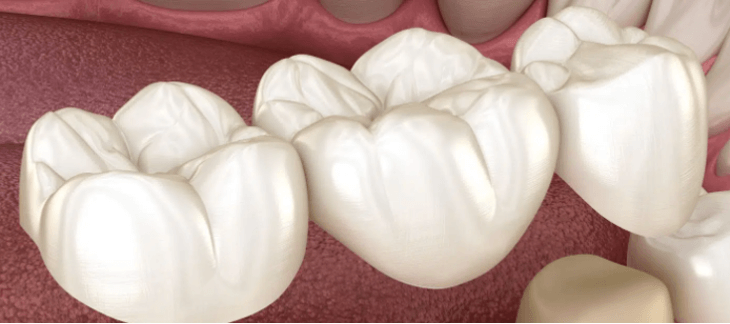
How it works:
The abutment teeth are prepared by removing some enamel to make room for the crowns. The bridge is then cemented onto these prepared teeth.
- Pros: Strong, stable, relatively straightforward procedure, common and widely available.
- Cons: Requires reshaping healthy adjacent teeth, which is irreversible. If the abutment teeth are not strong enough, they can fail.
Ideal use:
When healthy natural teeth are present on both sides of the missing tooth.
2. Cantilever Dental Bridge
A cantilever bridge is used when there are healthy natural teeth on only one side of the missing tooth gap.
The pontic is anchored by a crown or crowns on one or two abutment teeth located next to each other on the same side of the gap.
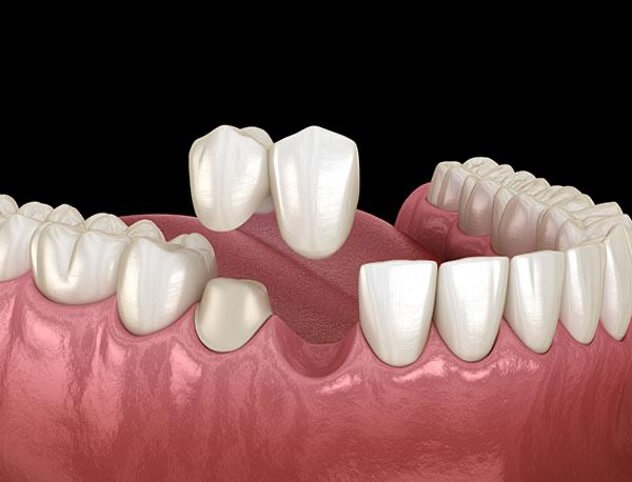
How it works:
Similar to a traditional bridge, but the pontic extends out from the abutment teeth without support on the other side.
- Pros: Useful when there’s only one adjacent tooth available for support.
- Cons: Can place extra stress on the abutment teeth, potentially leading to complications like loosening or tooth fracture. Less common due to these risks.
Ideal use:
In areas of the mouth under less stress (like front teeth) when there’s only one adjacent anchor tooth.
3. Maryland Dental Bridge (Resin-Bonded Bridge)
This type of bridge uses a metal or porcelain framework with “wings” that are bonded to the backs of the adjacent teeth, rather than covering them with crowns.
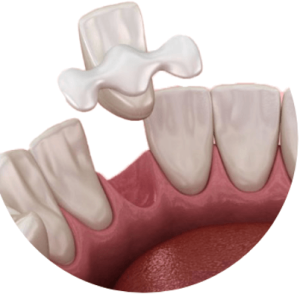
How it works:
The pontic is attached to a framework that is bonded to the lingual (tongue-side) surface of the adjacent teeth. This requires minimal preparation of the adjacent teeth, if any.
- Pros: Minimally invasive (doesn’t require significant reshaping of adjacent teeth), more conservative, often less expensive than traditional bridges.
- Cons: Can be less strong than traditional bridges, bonding can sometimes fail, framework might show through thinner enamel.
Ideal use:
For missing front teeth where bite forces are lower, especially in younger patients with healthy, unrestored adjacent teeth.
4. Implant-Supported Bridge
Instead of relying on natural teeth for support, an implant-supported bridge is anchored by dental implants.
This type of bridge is used when multiple teeth are missing in a row or when the adjacent natural teeth aren’t strong enough to support a traditional bridge.
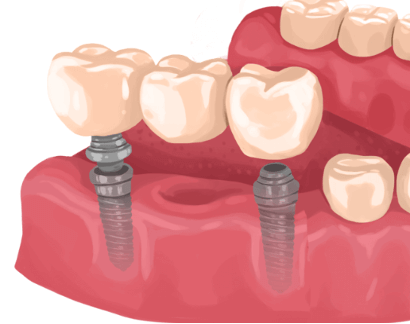
How it works:
Dental implants are surgically placed into the jawbone to serve as stable roots. Once the implants have integrated with the bone, the bridge is attached to them.
- Pros: Very strong and stable, does not require preparation of adjacent natural teeth, helps preserve jawbone health (like implants).
- Cons: More complex and often more expensive procedure than traditional bridges, involves surgery, and requires a longer treatment timeline.
Ideal use:
When multiple teeth are missing, or when adjacent natural teeth are not suitable for traditional bridge support.
Materials Used in Dental Bridges
Dental bridges are fabricated from various materials, each offering different combinations of strength, durability, and aesthetics.
The choice of material often depends on the bridge’s location in the mouth (front vs. back), the patient’s budget, and desired appearance.
Common materials include:
- Porcelain or Ceramic: Excellent aesthetic appeal, mimicking the look of natural teeth. Best for visibility, but can be more prone to chipping than metal-based options.
- Metal Alloys: Often used for the underlying framework of porcelain-fused-to-metal bridges or for full-metal bridges (typically in the back of the mouth where strength is paramount and aesthetics are less critical). Highly durable.
- Porcelain-Fused-to-Metal (PFM): Combines the strength of metal with the aesthetics of porcelain. A strong, durable option, though the metal margin can sometimes be visible at the gum line.
- Zirconia: A strong, tooth-coloured ceramic material that offers both excellent aesthetics and durability. Often used for full-zirconia bridges, providing a metal-free, highly aesthetic and strong option.
- Composite Resin: Primarily used for Maryland bridges or temporary bridges. Less durable than ceramic or metal options.
Your dentist in Markham will discuss the best material options for your specific needs and preferences.
The Dental Bridge Procedure: A Step-by-Step Guide
Getting a dental bridge typically requires two or more appointments at your Markham dental clinic. Here’s a general outline of the process:
Appointment 1: Preparation and Impressions
- Initial Consultation and Assessment: Your dentist will examine your teeth and gums, take X-rays, and discuss your medical history to determine if a dental bridge is the right solution for you. They will assess the health of your adjacent teeth (if using a traditional bridge) or discuss implant placement if considering an implant-supported bridge.
- Preparing the Abutment Teeth: If you are receiving a traditional or cantilever bridge, the dentist will numb the area and then reshape the abutment teeth. This involves removing a small amount of enamel from the sides and top of the teeth to create space for the crowns that will fit over them.
- Taking Impressions: After preparation, impressions (molds) of your teeth will be taken. These impressions capture the exact shape of your prepared teeth, the gap, and the surrounding teeth. This mold is sent to a dental laboratory where your custom-made bridge will be fabricated. Digital scans may also be used instead of traditional impressions.
- Temporary Bridge Placement: While your permanent bridge is being made at the lab (which can take a week or two), your dentist may place a temporary bridge. This protects your prepared teeth, helps maintain the space, and allows you to function relatively normally. You’ll receive instructions on how to care for your temporary bridge.
Appointment 2: Permanent Bridge Placement
- Checking the Fit and Bite: Once your permanent bridge arrives from the lab, you’ll return for your second appointment. Your dentist will remove the temporary bridge and carefully place the new permanent bridge in your mouth. They will check the fit of the bridge, ensure the bite is comfortable and correct, and verify that the bridge looks aesthetically pleasing with your other teeth.
- Permanent Cementation: If the fit, bite, and appearance are satisfactory, the permanent bridge is cemented onto the prepared abutment teeth. This cementation is a strong, durable bond designed to hold the bridge securely in place for years.
- Final Adjustments and Aftercare: Minor adjustments may be made to the bridge after it’s cemented. Your dentist will provide detailed instructions on how to care for your new bridge, including proper oral hygiene techniques. A follow-up appointment may be scheduled to check on the bridge after some time.
For implant-supported bridges, the process involves initial surgical placement of the implants, a healing period (osseointegration, which can take several months), and then attaching the bridge to the implants in subsequent appointments.
Dental Bridges vs. Dental Implants: Making the Right Choice in Markham
When replacing missing teeth, two common fixed options are dental bridges and dental implants. Both are effective, but they have key differences.
Understanding these can help you make an informed decision with your dentist in Markham.
| Feature | Dental Bridge | Dental Implant |
| Support/Anchoring | Anchored to adjacent natural teeth (or implants) | Anchored directly into the jawbone |
| Procedure | Typically 2 appointments; less invasive than implant surgery | Requires surgical placement of implant(s); longer healing period |
| Impact on Adjacent Teeth | Traditional/Cantilever require reshaping healthy adjacent teeth | Does not affect adjacent teeth |
| Longevity | Typically lasts 5-15 years with proper care | Can potentially last a lifetime with proper care |
| Bone Health | Does not stimulate the jawbone; bone loss can occur over time in the missing tooth area | Stimulates the jawbone, helping to prevent bone loss |
| Cost | Generally lower initial cost | Generally higher initial cost |
| Candidacy | Requires healthy adjacent teeth (for traditional/cantilever) | Requires sufficient bone density and good overall health |
Ultimately, the choice between a bridge and an implant depends on various factors, including your overall health, the condition of your remaining teeth and jawbone, the location of the missing tooth, your budget, and your personal preferences.
Your dentist can assess your specific situation and recommend the best solution for you.
Understanding the Cost of Dental Bridges in Markham
The cost of a dental bridge in Markham, like anywhere else in Ontario or Canada, can vary significantly.
It’s challenging to give a single price, as several factors influence the final expense:
- Type of Bridge: Traditional and Maryland bridges are typically less expensive than Cantilever or Implant-Supported bridges. Implant-supported bridges involve the cost of implant surgery, which adds significantly to the total.
- Number of Missing Teeth: Replacing more than one tooth with a bridge will increase the cost.
- Materials Used: Bridges made with higher-end ceramics like Zirconia tend to be more expensive than those using metal alloys or porcelain-fused-to-metal.
- Complexity of the Case: Difficult placements, additional necessary treatments (like gum therapy or treatment of abutment teeth), or custom shading can increase costs.
- Geographic Location: Costs can vary slightly between different dental practices and regions.
Typical Cost Ranges in Ontario (Approximate):
While exact prices vary, a traditional dental bridge replacing one missing tooth in Ontario might range anywhere from $1,000 to $5,000 per unit (a unit counts each crown and each pontic; a bridge replacing one tooth with two crowns is typically 3 units).
- A 3-unit traditional bridge could potentially cost between $3,000 and $15,000 before insurance, depending heavily on materials and complexity.
- Implant-supported bridges involve the cost of the implants themselves (which can be $1,000 – $6,000+ per implant) plus the cost of the bridge attached to them.
Dental Insurance Coverage:
Most private dental insurance plans in Canada provide some coverage for dental bridges, as they are often considered a major restorative procedure.
Coverage typically ranges from 50% to 70% of the cost; however, check your specific plan details, as coverage levels and annual maximums vary widely.
Your dental office team can help you understand and navigate your insurance benefits.
Canada Dental Care Plan (CDCP):
It’s important to note that as of the current understanding, the Canada Dental Care Plan (CDCP) does not cover dental bridges.
While it provides coverage for many essential services like cleanings, exams, fillings, dentures, and crowns, dental bridges are not listed as a covered benefit.
If cost is a significant factor and you are eligible for the CDCP, discussing alternative treatment options like dentures or potentially crowns on severely damaged teeth (which are covered) with your dentist is crucial.
To get an accurate estimate for your specific situation, schedule a consultation at a Markham dental clinic.
They can provide a personalized treatment plan and a detailed breakdown of the expected costs.
Caring for Your Dental Bridge: Maintenance for Longevity
With proper care, a dental bridge can last many years, often between 5 and 15 years, sometimes even longer.
The longevity largely depends on the health of the abutment teeth (for traditional bridges) or implants and the surrounding gums.
Caring for your bridge is essential to protect your investment and maintain your oral health.
Here are key maintenance tips:
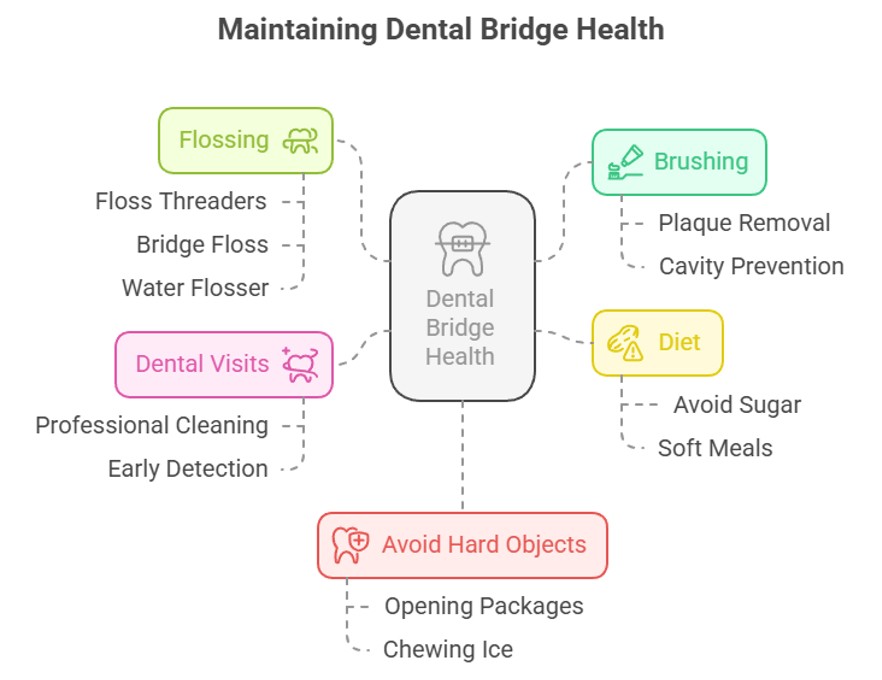
- Diligent Oral Hygiene: Brush your teeth twice daily with fluoride toothpaste.
- Flossing Daily: This is crucial! You need to clean not only around your teeth but also underneath the pontic (the artificial tooth) of the bridge to remove food particles and plaque. Special tools like floss threaders, bridge floss, or interproximal brushes can help you clean under the pontic. A water flosser can also be very effective.
- Healthy Diet: Limit sugary snacks and drinks. Avoid excessively hard, sticky, or chewy foods that could potentially damage the bridge or the underlying teeth/gums.
- Regular Dental Check-ups and Cleanings: Visit your dentist and hygienist regularly (usually every six months). They can professionally clean the areas you might miss and check the condition of your bridge, abutment teeth, and gums. Early detection of problems can save your bridge.
- Avoid Biting Hard Objects: Don’t use your teeth (or bridge) to open packages, chew ice, or bite on hard candies.
Signs that your bridge may need attention include: the bridge feeling loose, sensitivity in the abutment teeth, pain when chewing, or noticeable wear or damage to the bridge material.
Contact your dentist if you notice any of these issues.
Who is a Good Candidate for a Dental Bridge?
A dental bridge is a suitable tooth replacement option for many individuals, but not everyone.
Ideal candidates generally:
- Have one or more missing teeth.
- Have healthy natural teeth on either side of the gap that can serve as strong abutments (for traditional or cantilever bridges). These teeth should be free from significant decay or gum disease.
- Have healthy gum tissue.
- Are in good overall health.
- Are committed to maintaining excellent oral hygiene, especially around the bridge.
A bridge may not be the best option if the adjacent teeth are weak, heavily restored, or if there are too many missing teeth to be adequately supported by the remaining natural teeth.
In such cases, options like dental implants or partial dentures might be more appropriate.
Dental Bridges and Repairing Damaged Teeth
Dental bridges often play a role in the process of repairing damaged teeth. If a tooth is severely damaged by decay, fracture, or trauma and cannot be saved or restored with a filling or crown, it may need to be extracted.
A dental bridge can then be used to replace that missing tooth, restoring the gap left behind.
Furthermore, the adjacent teeth chosen to support a traditional bridge might require treatment themselves if they have existing damage or large fillings.
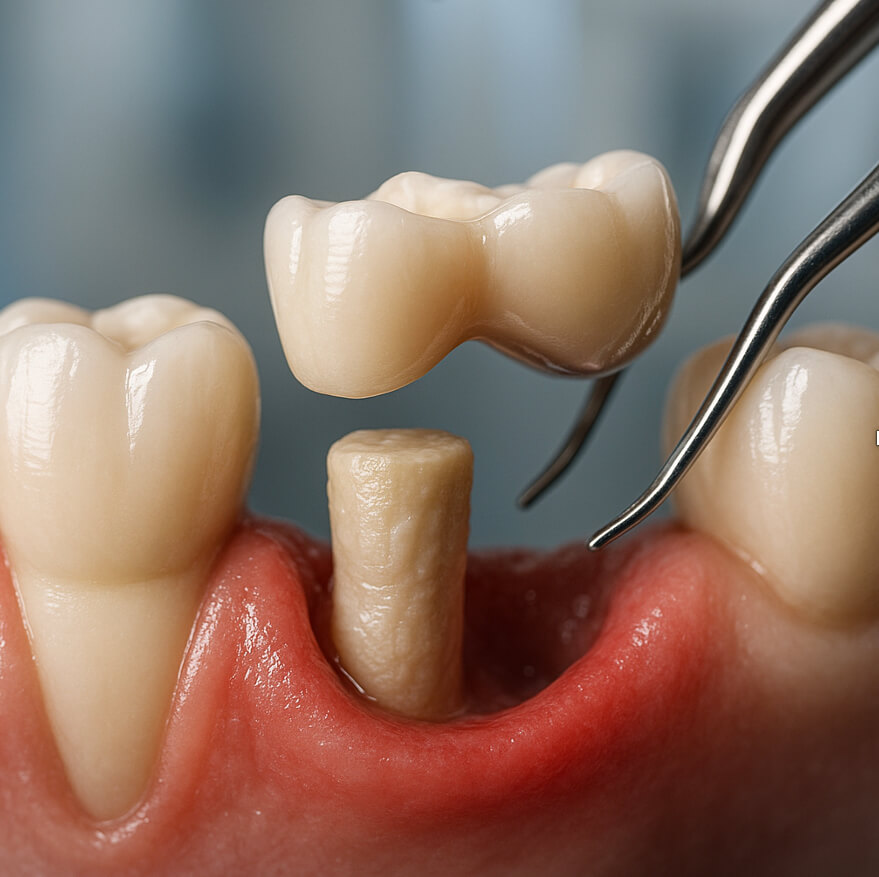
These teeth are often prepared and covered with crowns as part of the bridge structure, effectively repairing and strengthening them while also using them as anchors.
Why Choose Bur Oak Dental for Dental Bridges in Markham?
Choosing the right dental provider for your bridge procedure is as important as choosing the right type of bridge.
At Bur Oak Dental, we are dedicated to providing comprehensive, patient-centric care in a comfortable and welcoming environment right here in Markham.
- Experienced Team: Our dentists have years of experience in restorative dentistry, including the planning, preparation, and placement of various types of dental bridges.
- Patient Comfort: We understand that dental visits can cause anxiety. We offer amenities like massaging dental chairs and options like nitrous oxide sedation to help you feel relaxed and at ease throughout your procedure.
- Personalized Care: We take the time to listen to your concerns, thoroughly assess your needs, and explain all your treatment options, including the different types of bridges, materials, costs, and alternatives, ensuring you make an informed decision that’s right for you.
- Comprehensive Services: We offer a wide range of dental services, allowing us to address all your oral health needs under one roof, from initial assessment to complex restorative work and ongoing maintenance.
- Convenient Markham Locations: With three clinics located strategically across Markham (Bur Oak Dental West, Central, and East), accessing quality dental care is convenient for residents throughout the community.
We welcome new patients and offer free consultations to discuss your tooth replacement options and determine if a dental bridge is the right solution for your smile.
Conclusion
Dental bridges are a time-tested and effective solution for replacing missing teeth, restoring function, aesthetics, and preventing potential oral health issues. Whether you’re considering a traditional bridge, curious about Maryland bridges, or exploring implant-supported options, understanding the types, materials, and procedures is key.
While the cost can vary based on several factors, a dental bridge offers a fixed, stable way to regain your confident smile and ability to eat and speak comfortably. If you’re in Markham and have a missing tooth or teeth, we encourage you to explore whether a dental bridge is right for you.
Don’t let missing teeth hold you back. Contact Bur Oak Dental today to schedule a consultation at one of our convenient Markham locations and discuss how a dental bridge can help you achieve a healthy, complete smile.
Frequently Asked Questions About Dental Bridges
How much does a dental bridge cost in Ontario?
The cost varies widely depending on the type of bridge, the number of units (missing teeth + abutments), materials used, and complexity. A traditional bridge replacing one tooth might cost anywhere from $3,000 to $15,000 or more before insurance. Implant-supported bridges will be higher due to the cost of implants. Most dental insurance plans cover 50-70% of the cost of bridges as major restorative care.
Does the Canada Dental Care Plan (CDCP) cover bridges?
No, as of the current program details, the Canada Dental Care Plan (CDCP) does not cover dental bridges. It does cover other restorative services like crowns and dentures, which may be alternative options depending on your situation.
Are dental bridges worth the money?
For many patients, yes. Dental bridges are a durable, fixed solution that restores function, aesthetics, and prevents adjacent teeth from shifting, which can lead to further problems. The “worth” depends on your individual needs, budget, and comparison to alternatives like implants or dentures.
Who is not a good candidate for a dental bridge?
Individuals with significant gum disease, weak or unhealthy adjacent teeth (for traditional/cantilever bridges), or insufficient jawbone density (for implant-supported bridges) may not be good candidates. Your dentist will evaluate your specific situation.
When is a bridge not an option?
A bridge might not be an option if there are no suitable healthy teeth or implants to serve as abutments, if too many teeth are missing in a row to be reliably supported by a bridge, or if the patient has uncontrolled gum disease or other systemic health issues affecting oral healing.
How do you maintain a dental bridge?
Maintaining a bridge involves brushing twice daily, flossing daily (using tools like floss threaders, interproximal brushes, or water flossers to clean underneath the pontic), avoiding hard/sticky foods, and attending regular dental check-ups and cleanings.
How often do dental bridges need to be replaced?
With excellent oral hygiene and regular check-ups, dental bridges typically last between 5 and 15 years. The lifespan depends on the type of bridge, materials, bite forces, and the health of the supporting teeth or implants.
What are the disadvantages of dental bridges?
Disadvantages can include the need to potentially reshape healthy adjacent teeth (traditional/cantilever), increased stress on abutment teeth, potential for decay or gum disease under the bridge if not cleaned properly, and a shorter lifespan compared to dental implants.


